Using soldering irons, you can join two metals or objects together with utmost precision. Not every soldering iron kit is designed to be the same. In order to choose the best soldering iron kit, you have to consider below factors…
- Wattage: Soldering irons come with wattage range between 15 to 20 wattage.
For small PCB works – 15 to 25 watts For general soldering works – 40 watts For complicated and advanced works -50 to 60 watts
- Temperature Control: Every project has different temperature requirements. Soldering irons come with or without temperature control. It is better to choose a model with temperature control as you can increase or decrease the temperature according to the task. Soldering iron with no temperature control is cheaper but they are only suitable for simple household tasks. Some other factors to consider are tip compatibility, quality, anti-static, holding stand, and soldering accessories. We have mentioned them clearly in our “Buying Guide”. After comparing several models available in the market, we have shortlisted the best soldering iron kits.
Best Soldering Iron Kits List
10 Best Soldering Iron Reviews
1.Anbes Soldering Iron Kit
Best cordless soldering irons Best solder for electronics Soldering helping hands Soldering: stations, desoldering
Anbes has a brought an allrounder electronic soldering iron kit which contains everything you need. It is very easy to carry and used for welding circuit board, appliance repairs, home DIYs, jewellery welding, and much more. We rank this product first due to its extremely useful components. It is a 14-in-1 kit containing a vast array of tools. The support station has a double spring sponge iron holder which is safe to use. The soldering iron heats up very fast and has 5 multiple soldering tips replacement feature. The iron head is not easy to drop due to its impact-resistant design of screw thread. It works on 60W 110V. The solder sucker disordering pump has an aluminium body frame and has a high-pressure vacuum tube. It can be used with one hand and it is very effective. It is used for removing solder from PCB through hole solder joints. Features
Work Voltage: 110V Power: 60W Temp Range: 200℃ – 450 ℃
Components Included
Soldering Iron Desoldering Pump Wire Stripper Cutter Soldering Iron Stand Tweezers 2 X 24awg Electronic Wire 5 Different Soldering Iron Tips Tin Wire Tube PU Carry Bag
2. Plusivo Soldering Iron Kit
It is a complete soldering kit with multimeter from Plusivo. It has all essential tools used for home DIY fixing jobs, soldering projects, circuit board welding, crafts/jewelry making, electrical, electronics and appliances repairs, etc. It is equipped with adjustable temperature knob, four ventilation holes, heat resistant grip, metal base, cleaning sponge, spring holder, 5 pieces replaceable tips set, and tin wire solder tube. It features a multimeter and 20+ bonus items in the kit are used for both soldering and de-soldering. It comes with a durable PU bag, which let you organize all the components, store it properly and carry it easily. Also, you can download Ebook, a bonus that guide you in soldering journey. The manufacturer offers 30-day money back/replacement guarantee on their product. Features
Working Voltage: 110V Power: 60W Adjustable Temperature: 200°C – 450°C Item Weight: 1.016 kg Soldering Stand: Steel Carry Bag: PU Power Source: Battery (2 AAA batteries) Style: Soldering/Welding
Components Included
Adjustable Temperature Soldering Iron (60W) Digital Multimeter with Premium Probes Soldering Iron Stand Tweezers (Straight ESD-11, Curved ESD-15) Diagonal Wire Cutter, Mini Wire Stripper Tool, and Cutter Desoldering Pump 5 Soldering Iron Tip Set Tin Wire Solder Tube Mini PCB and Mini Screwdriver Solder Wick and Soldering Paste Heat Shrink Kit (Bonus) Red 22 and Black 22 AWG Wire Pen Shaped Screwdriver Insulating Tape (red, black, and yellow) Ebook
3. HANDSKIT Soldering Iron Kit
HANDSKIT soldering iron kit is suitable for beginners and professionals alike. It is helpful for various applications including electronic work, DIY soldering, computer circuit board repair, jewelry works and industrial soldering. It is equipped with inner-heated ceramic technology which heats up quickly. It also has a heat and impact resistant design of screw thread. So, the iron head will not drop easily. It comes with an adjustable temperature range from 200 degrees Celsius to 450 degrees Celsius. The kit includes tips, solder wire, PY bag, anti-static wires, wire stripper, rosin and stand with cleaning sponge. As all the products are compact, you can easily store them in the bag provided. Features
Work Voltage: 110V Power: 60W Temp Range: 200℃ – 450 ℃
Components Included
Soldering Iron De-soldering pump Solder wire Anti-static tweezers Wire stripper Rosin PU bag Stand with cleaning sponge Tips
4. Anbes Soldering Iron Kit
This is one of the most well-functioning Soldering Iron Kits which has FCC and RoHS certification. This can be easily used for Dyer, various electronics chipboards, welding, watches, mobile device, computer hardware, TV capacitors etc. Anbes comes forth because of the often malfunctioning temperature dial and the soldering tips. Other than that, the soldering pumps have a high-pressure vacuum which can remove solder from the circuit board easily. The multimeter can be operated by both AC/DC current. The soldering iron has an adjustable temperature which can be preheated within 30 secs and it has a LED indicator which makes it safe for welding purposes. It also has a simple ON/OFF switch. The soldering iron heats up fast and has heat dissipation property for which it cools down easily. It has adjustable temperature and has ceramic-core technology. It has a 12 months warranty and lifetime customer support. Features
Temperature: 200-450˚C Weight: 689gms Working voltage: 110V Work output: 60W
Components Included
Desoldering Pump Screwdriver Anti-static Tweezer 2 Solder Wires 2 Tips Wirecutter Multimeter Soldering Stand
5. Q-Ming Soldering Iron Kit
Q-Ming offers a pencil-style soldering iron that has a flexible design to easily repair jewelry, watches, mobiles, hardware, guitars, and circuit boards. This soldering iron consumes just 60W, yet offers a main feature like adjustable temperature, so you can use it for all types of applications. Moreover, the iron gets heated in just 15 seconds as it uses an advanced ceramic heating core. In the package, you get 5 iron tips, a stand to place the iron, and a soldering wire to get started with your job immediately. Features
Work Voltage: 110V Power: 60W Temp Range: 200℃ – 450 ℃
Components Included:
Soldering Iron. Wire Stripper Cutter. Soldering Iron Stand. Tin Wire Tube. 4 Different Soldering Iron Tips.
6. GLE2016 Electric Soldering Welding Iron Kit
This product is a temperature adjustable solder iron which can be used to solder and weld circuit boards, DIY projects, costume jewellery and small electronic boards etc. This product is seventh because the soldering tips do not last long and the soldering gun shows some problems with some usage. However, this product is still on the list due to its vivid features. It heats up within 2 minutes and powered with the ceramic heater core. It is easy to use and can be operated by one hand and has a non-slip soft rubber handle for comfortable use. For warranty contact the manufacturer for details. Features
Work voltage: 110V Power: 60W Temp range: 200°C~450°C
Components Included
1 x Soldering Iron 1 x Solder Wire (82%Sn, 18%Pb, 1mm Dia., 0.71 oz) 5 x Extra Soldering Iron Tips
7. Sremtch Soldering Iron Kit
This soldering iron kit uses ceramic core induction technology, adjustable temperature with large venting holes, on/off switch, insulating silica gel, and rapidly heats up in 30 seconds will make it energy saving and ensures safe welding. It is suitable for various applications like welding, DIY, repairing electronics and circuit board, watches, mobile device, jewelry, computer hardware, TV capacitors, etc. Suits perfect for both beginners, hobbyists, and professionals. Due to its often-malfunctioning temperature dial and soldering tips, SREMTCH Kit comes in this position. Other than this, it has 57m cable length, & lightweight, which can be used for a long time. it is easy and quick to be soldered. The tool set comes in a PU carry bag with well-organized way. For warranty contact the manufacturer for details. Features
Work Voltage: 110V Power: 60 W Temperature Range: 200°C – 450°C Weight: 100 grams Soldering Stand: Steel Metal Soldering Iron Length: 7 inches Cable Length: 57.5 inches.
Components Included
Adjustable Temperature Soldering Iron Stainless Steel Soldering Iron Stand Desoldering Pump 5 Soldering Iron Tips Solder Wire (100g/0.8mm) Yellow Sponge Pad PU Carry Bag
8. LDK Soldering Iron Kit
LDK iron kit comes with all the required components in a single kit. It has an adjustable temperature feature and upgraded heat resistant material. This is in the ninth position because the soldering tips do not work well and there is no LED output. This product still hits the list because of its easy cooling process that is by the presence of the 4 ventilation holes. The desoldering pump comes with a high-pressure vacuum tube which is best for removing PCB through hole solder joints. For the warranty, you need to contact the manufacturer. Features
Work voltage: 110V Power: 20W-60W Temp range: 200℃ ~ 450℃ Soldering stand: Stainless Steel
Components Included
1 Soldering Iron: From 200℃ to 450℃ (392℉ to 842℉ ) 5 Extra Different Soldering Tips 1 Solder Wire 1 Anti-Static Tweezers 1 Solder Sucker 1 Cleaning Sponge 1 Soldering Iron Stand 1 User Manual
9. Ambberdr Portable Soldering Iron Kit
The soldering iron kit from Ambberdr comes with all the necessary components. It is suitable for a wide range of applications that include costume jewelry, electronic circuit boards, small appliances and DIY home repairs. As all the components are provided in an organized bag, you can carry it easily to your workplace. The soldering iron comes with a ON-OFF switch which makes it safe and convenient to use. As the soldering iron has a ceramic tube, it heats up quickly. It comes with adjustable temperature between 392℉ – 842℉ or 200℃ – 450℃. When it comes to desoldering pump, it is quite easy to use. And moreover, you can press the trigger button with just one hand. The high pressure from the vacuum will remove the solder efficiently. Features:
Work Voltage: 110V Power: 60W Temp Range: 200℃ – 450℃
Components Included:
Adjustable temperature soldering iron Multimeter including probes Soldering iron stand Wire stripper cutter Heat shrink kits Electronic wires De-soldering pump Mini PCB Pen shaped screwdriver Tin wire solder tube Tweezers Knife Insulating tape PB bag
10. K KERNOWO Soldering Iron Kit
K KERNOWO offers a pencil-type soldering iron with LCD display that displays the current temperature the device is using. Also, you can adjust the temperature from 200 to 500 degrees Celsius to carry out various soldering applications like circuit boards, home repairs, computers etc. This soldering iron has a 90W heating element that quickly heats up the iron in just 20 seconds. Meanwhile, the handle remains cool no matter how high the temperature of the iron is. The soldering iron measures 10.55 x 2.68 x 2.44 inches and is easy to carry anywhere. Moreover, it weighs just 5 ounces, so you experience any hand pain while soldering. Features:
Work Voltage: 110V Power: 60W Temp Range: 200℃ – 500 ℃
Components Included:
Adjustable Temperature Soldering Iron. Solder Rosin Paste Flux. Soldering Iron Stand. Soldering Wire.
What is a Soldering Iron?
Soldering iron is a handheld tool that can be used for several electronic projects. It comes with a tiny blow torch that provides heat to metal parts in order to connect two pieces together. Soldering irons are available in different types like adjustable soldering irons, pencil irons, soldering iron station and soldering guns. Every soldering iron kit has its own perks and cons. Some types are suited for certain projects while others are not. However, the basic working principle of these types is essentially similar. Filler material, also known as solder is used by these tools to combine the metal pieces together. The soldering iron tip gets heated up which turns the solder into liquid. When the liquid comes in contact with two objects, it will join them together once it hardens. However, it is completely different from welding – where the objects are heated and combined together. Usually, soldering is suitable for delicate jobs like stained glass mosaics, repairing electronic circuits, fusing copper pipes, and making jewelry. The bond that is made using solder is electrically conductive which them perfect for connecting wires and other electrical components.
How Much Hot Does a Soldering Iron Get?
Soldering iron are used for handling several projects that include electronics as well. They use power source in order to heat up the tip. Hot tip will melt the solder which allows the conductive material to join two objects together. Required heat temperature depends on the application type. Mostly, solder starts melting at 380 degrees Fahrenheit. Some soldering irons come with the capability of producing more temperatures than 380 degrees Fahrenheit and some can even go up to 80 degrees F. However, some of the soldering irons have only fixed temperature settings. Most of the soldering irons come with adjustable dials that let you adjust the heat temperature according to your application.
How To Choose a Soldering Iron?
Investing in an underpowered iron can be frustrating to use and a waste of your money. Because, you will end up with ruined kits and damaged components. With a bad soldering iron…
It takes a lot of time to heat the joint. And moreover, it also takes time to spread the heat to components while soldering. This can sometimes to damaging or overheating the component. If it has longer heating times, then it takes time for oxides to form on soldering surfaces. It will prevent solder from flowing and result in a weak joint. Long recovering times of solder between joints can result in cold joints.
To purchase a soldering iron, you don’t have to shell out a fortune. Advanced features like interchangeable tips and temperatures are good to have but they are not necessarily to important for hobbyists or beginners. In order to help you out, we have provided all the information and factors to consider while purchasing a soldering iron. Read it carefully to take an informed decision.
1. Wattage
Wattage is the first important thing to consider while purchasing a soldering iron. Because you may want to investment in an iron that can heat up quickly and maintain even temperature throughout the completion of the task. Usually, soldering irons that are particularly used in electronics come in the wattage range of 20 to 60. Soldering irons that come with 50W are common as they provide enough heat for most of the projects with circuit boards. Soldering iron with higher wattage (40W to 60W) doesn’t mean they apply more heat to the solder joint. It represents that the iron has more power available to complete complex tasks. As most of the soldering stations have a knob on the power station, you can adjust the temperature on iron tip according to your requirements. When it comes to soldering irons with low wattage like 20W to 30W – they lose the heat faster resulting in weak or bad solder joints. Power consumption of a soldering iron is often mentioned with the product specifications. Basic non-temperature control irons with 40Watts are ideal for general soldering works. For heavy soldering, look out for higher wattage. For small PCB works, we recommend 15 to 25Watts. Soldering irons with temperature controls come with higher wattage as the user can control the temperature as required. Some hobbyists or beginners may choose models with less power in order to save money. Soldering irons that come with lower wattage (20 to 30) can get the job done. But as already mentioned they take more time to heat and lose the heat quickly.
2. Voltage
Most of the soldering irons available in certain countries will come with the correct mains voltage. For example, in UK it is 230 volts, 115V in USA. Some soldering irons come with 12V as well. Some models are made for special applications that require low voltage. So, choose according your requirements.
3. Temperature Control
It is one of the main features to look out – as different soldering tasks requires soldering at different temperatures. Two types of temperature controls are available in soldering irons. Less expensive soldering iron employs no form of electronic regulation. This means when the required temperature is achieved, heat loss will be equal as heat generated. Most models have thermostatic control which means temperature can be regulated in a better way. Because you can control or adjust the temperature to desired value. These irons are much better because even when the heat is drawn away during soldering a large object, they will maintain the temperature throughout the task in a better way. Models with no regulation are much hard to maintain the temperature while soldering a large object. Some of the soldering irons with temperature control come with a digital display which provides insights of the current temperature. It is a great addition to have this feature. Another last model is no temperature control. These are the cheaper ones but not good in soldering as they may damage the components. If your requirement is to solder only household projects, then this model should be sufficient enough.
4. Tip Compatibility and Replacement
It is better to choose a model that comes with replaceable tips and the soldering iron should be compatible as well. Iron tips are available in different sizes which are capable of handling different soldering tasks. Another important aspect to consider while purchasing a soldering kit is the cost of tips. Some soldering irons are compatible with tips from specific brands only. Soldering iron tips wear over the time and get oxidized so over the long run they can be expensive than soldering iron alone. Ideal soldering irons are compatible with tips from any brand. This is actually quite handle, especially during the times when they break down.
5. Size and Shape of Tips
As you already know soldering irons with interchangeable tips which come in different shapes like chisel, conical, tapered and pyramid. Material used for making them also is different from one another. Some materials are nickel, copper, and chrome. Different types of tips are suitable for doing different types of jobs. Shape and size of the soldering tip determines how you lay the bead. Different tips are designed for different applications. They have their own benefits and drawbacks. Before purchasing any tip, first factor to consider is whether it is compatible with your soldering station. Most of the tips have same design and most of the irons use interchangeable tips. However, you have to check the size with manufacturer’s manual and purchase the tip according to the requirement. You should also consider the tip shape as well. For beginners, chisel tip is the best option because it comes with a flat surface do it will hold together nicely. You can position it in different ways to work with a different component sizes and wires. They are perfect for wire-to-wire joints, de-soldering components, through-hold breadboard and SMDs. Hoof tips are suitable for drag-soldering multiple surface mount pads. However, only professionals with advanced skills use this technique. If you have to work on SMD devices or more advanced soldering projects, then hoof tip is the right choice. Conical tips are very difficult and tricky to use. However, their work is precise which makes them suitable for advanced users only. Last thing you have to check is the material of the tip. When it comes to durability, iron tips are perfect. And moreover they are cheaper to purchase. However, they font hold or transfer the heat as perfectly as copper tip. High end soldering irons come with iron coated copper tip which provides best of both options.
6. Anti-Static Protection
Electric components are susceptible, especially the advanced integrated circuit chips and static protection is a bit problematic. Though most of the components used in home constructions are not susceptible to damage by static but few of them are. That is why, it is better to consider soldering iron with static protection.
7. Holding Stand
This is an important factor because you have to place the hot iron somewhere it is safe after completing the work. A soldering iron stand will prevent the iron form rolling around and protect from possible injuries like burns. Most of the iron holders come with sponge and tray which lets you clean the soldering iron perfectly. As irons reach temperature around 300C, it is important to make sure they are placed in a secured placed.
8. Leaded Vs Lead-Free Solder
One of the important things to consider while purchasing the soldering iron is material used for solder. Previously, solder was comprised of Pb(Lead), tin(Sn) and other trace metals. It is often referred as leaded solder. But lead is a harmful to our health and if exposed to large amounts, then there is a possibility of lead poisoning. However, lead is considered as useful material and perfect for soldering because it has low melting point which help the user create strong solder joints. Because of the harmful effects of lead, some countries have decided to prevent the use of solder. In 2006, RoHS (European Union adopted the Restriction of Hazardous Substances Directive) has restricted the use of lead as solder in electrical equipment and electronics. Since then, lead-free solder has become much popular and common. Lead-free solder is same as the leaded counterpart expect it doesn’t contain any lead. It comprises of tin and other trace materials like copper and silver. This type of solder is usually marked with RoHS symbol in order to provide assurance of authenticity.
9. Soldering Accessories
If you are beginner with less experiencing in soldering, the having additional accessories can be extremely beneficial. We have mentioned some of the additional accessories are mentioned below…
Solder: The easiest ones to work with are 60/40 (lead/tin) which means 40% tin and 60% lead which is the perfect combination of electric solder. They are suitable for both beginners and professionals with advanced skills. Alpha Fry provides best core solders and all their products are the best. Solder Wick: It is one of the best ways to clean the excess solder from a joint. Unlike other solder suckers, this accessory soaks up the molten solder. Cleaning Sponge: This product is helpful for cleaning the iron tip while soldering. As they are heavy duty sponge cleaners, they will get rid of corrosion present on the tips which regular sponges cannot clean. Tip Tinner: It is helpful to clean and re-tin the soldering iron tip which often gets black and oxidized. Diagonal Cutting Pliers: In order to trim the component leads, you will obviously require diagonal cutters. Vise: It helps you hold the work steady. This is the most helpful and important accessory as it ensures safety and sound joints. Helping Hand: It holds the components together while soldering. It is especially good for smaller boards as it holds everything together while splicing or terminating the wires. Flux Pen: It helps the flow of lead-free solder. Solder Vacuum Pump or Solder Sucker: It helps the tool to remove the any solder left behind while de-soldering the components. Compared to solar pumps, solder sucker/solder vacuum is the better option. Soldering Mat: It has to be placed on the bench you are working on. It protects the work bench from any mishaps while soldering.
10. Maintenance
While purchasing any soldering iron model, make sure it comes with spare parts that can be easily found when you want to replace. Though the soldering iron parts will work for several years, the tips have to be changed at regular intervals. To prevent unnecessary costs on maintenance, repairs or replacements, it is better to purchase high-end soldering iron which comes with temperature control and extra spare parts.
11. Ground Power Plug
A ground power plug of soldering iron has to be come with three-pong. It secures the iron against static discharges which can render sensitive electronic parts unless while soldering.
12. Brands
There are several popular electronic brands like Weller. Instead of choosing an unbranded model, we recommend to choose soldering iron that has durability and high quality. It is also important to look for good track record of manufacturers delivery and customer service. Branded soldering irons will rarely overheat, provide firm handling and have easy grip.
13. Price and Budget
The last but not least factor to consider while purchasing a soldering iron is the price you can spend. As there are several models ranging from $10 to $200, you can easily choose any one based on your requirements. Even if your budget is tight, you can still purchase a very good product. Most of the users go for mid-range soldering irons and still be happy with the durability and quality.
Different Types of Soldering Irons
Soldering irons come in several types which have their own perks and drawbacks. To purchase the best one according to your needs, it is better to understand the key differences between them. Some soldering irons emit immense heat and have quick melting points. While others are designed to allow the user to adjust the heat according to your requirement. Based on your needs, you have to choose the right soldering iron. There are several types of soldering irons, we have mentioned them below for your reference.
1. Simple Iron
If you want a conventional soldering iron form, then this option is perfect. It is usually operated on power rating between 15 and 35 Watts which is pretty much enough to handle basic electronic projects and repairs. Now-a-days, even simple soldering kits come with adjustable temperature controls which increases their versatility. They are suitable of routine users who like to have them for handling small repairs. They are affordable, simple and easy to use which makes them perfect for simple DIY electronic projects.
2. Soldering Station
Soldering stations have temperature control circuitry, display, electrical power supply and a soldering head with a temperature sensor. They also come with stands which lets you place or store the iron when not in use. A wet sponge is provided for cleaning the tip before and during the soldering process. Several additional accessories are also available in some soldering kits like vacuum pump, hot air gun and vacuum pickup tool. A soldering pencil is available in soldering station which is usually attached to the power station. Adjustable controls are provided so that you can increase or decrease the temperature of solder tip according to your requirements. Some of the models even come with electronic temperature control which lets you set and maintain the soldering iron tip at precise temperature. When it comes to price, soldering stations are bit expensive than simple iron. Soldering stations are capable of handling most of the soldering projects and very fine surface-mount components, even small ones like 0603 and 0805. Some soldering irons come with a thermostat that enable temperature control of the bit. It ensures temperature is maintained properly at all times. If the heat is being drawn without temperature rising too much, then a higher wattage element can be used for such cases to ensure good soldering. Irons with temperature control come with adjustment option while others even come with temperature indications. Soldering irons with temperature control are better and suitable for almost all the soldering projects. However, they are a bit expensive.
3. Soldering Gun
soldering guns are much similar to cordless hand drills. They have a wire looped tip which cools off quickly. So, it doesn’t require holsters. Because of its rapid cooling rate, there is less chance of any injuries or fire accidents. They are suitable for DIY enthusiast as they activate only when the trigger is pulled and have easy grip. The main component of a soldering gun is transformer which is capable of converting 110V AC in to lower voltage. The secondary winding transformer only comes with single turn. So, produces very low voltage and hundreds amperes of current. This high current travels through the copper tip. Due to high current flow, the soldering gun tip will heat up pretty quickly. It is easy to operate the soldering gun and has very short warm up time. However, it is not suitable for doing fine works on circuit boards and handling delicate soldering components with precision. Because, they generate more heat which can damage the components and circuit board as well. They are suitable for working with heavy gauge wires. Price range of soldering guns is around $20 to $70.
4. Soldering Rework
Repair and rework are complex tasks of soldering. They are usually used in high-volume manufacturing and industry facilities. Soldering systems have several hand pieces like hot air gun, thermos-tweezers, soldering iron, de-soldering gun and others. They are priced around $250 to $2500. Among all the brands, Pace is considered one of the most popular one. Professional temperature control soldering iron come with interchangeable tips. They consume 50 Watts or more power. The temperature control lets you set the tip at precise level you desire. Interchangeable tips options let you choose the ideal one according to your requirements.
5. Soldering Tweezers
Soldering tweezers have two electronic terminals. They are capable of working with diodes, batteries, resistors, capacitors and niche objects. Most of the tweezers are available in free-standing while others can be operated from a station. Tweezers usually come with heated tips which have to be controlled manually. You just have to squeeze gently for the device to work.
6. Soldering Torch
Soldering torch works on fuel or propane gas. It delivers short bursts of heat which is mostly required for melting metals. They are mostly used by jewelers. They are suitable for experienced users as only professionals can handle them without getting hurt. Considering safety aspects, beginners are not recommended to try them.
How to Use a Soldering Iron?
Be it for making jewelry, home repairs or repairing electronic circuits, soldering iron is an important tool in a workshop. Though the idea of soldering may look like a tough one, with some basic information even beginner can pretty much nail it. Basic soldering steps are quite simple. We have mentioned them below for your reference…
Initially, you have to heat up the soldering iron to desired temperature setting. Using a wet cleaning sponge, clean the soldering tip before using the tool and throughout the process as well. After the tip is clean, let it touch the object you want to solder. Once 2 seconds are complete, add some more solder in the joint area where you want to join the two objects. The heat will transfer the solder into a liquid and pliable substance. Instead of heating the solder by pressing the tip, let the heat transfer to solder. If you place the tip directly on the solder, then it can lead to brittle joints which may not capable of conducting electricity. Once the solder is melted and joints the objects, make sure to keep the work piece undisturbed until the solder is cooled and joint is strong.
Safety Tips to Consider While Using a Soldering Iron
As soldering iron tips can get hot over 300 degrees, it is better to consider certain tips to be safe while using it. We have mentioned them below for your reference.
As iron tips can get very hot, we recommend avoiding poking your partner with it. Make sure to wet your sponge to clean the iron. Though this seems a small thing, if it is not properly followed you may end up damaging the iron. Dry iron will not remove the corrosion of soldering iron instead it damages it. Every time you hold up the iron for soldering give it a quick swipe with wet sponge. This will help soldering much quicker and cleaner. Iron tip is not the hottest part of the soldering iron. It requires dome practice to learn how to use the right are of the iron to join. If you are sitting in same place for a long period and nothing is flowing, then take a step back, clean the tip, add solder again to the tip and start soldering again. Soldering iron can only heat the solder, it cannot solder itself. You have to use the iron for heating two things – board and part. Never add some solder to tip and rub it against the two things. Using the iron side, heat the two parts and add the solder from the opposite side. Don’t try to achieve perfectionism. If the solder joint look ok, then move on. Don’t solder, re-touch or re-solder again. If you solder again, then the heat can stress the PCB and it can further delaminate the board, pads, lifting traces and destroy the board. While soldering joints with thermal weight, let the joint heat up for additional 5 to 10 seconds. If you are soldering a big part of a pad with lot of copper, then let the iron heat for another few seconds so that heat gets into the part so that it can form a strong connection. If the iron tip feels sticky or if you see solder balling to the pin, then it indicates that heat is not sufficient enough. Make sure to hold the joint for few extra seconds to flow the solder properly.
How is a Soldering Iron Different from Soldering Gun?
Compared to soldering irons, soldering guns provides more power voltage over 100 to 140 volts. And moreover, they let the user work even in small spaces which is challenging to achieve with soldering kits. Unlike soldering iron, their tip is shaped like copper wire’s loop which provides excellent flexibility. Soldering guns are suitable for both metal projects and massive connections that usually require lighter touches. And also perfect for heavier wire tasks, complicated electrical connection and other professional work. In contrast to soldering guns, soldering irons are lights which makes them suitable for tasks that need soldering over long periods. Being flexible, they are suitable for several projects ranging from DIY’ers and heavy duty jobs. Small irons are suitable for lighter assembling projects and electronic installation. They don’t have to be switched off or on repeatedly as they will stay hot very long. Below is a breakdown of each type… Soldering Gun:
Suitable for heavier workpieces Doesn’t have a lot of varieties Heats up quickly Doesn’t offer more voltage than soldering irons
Soldering Iron:
Heats up slowly Has less voltage than soldering guns Suitable for lower power projects Come with a lot of varieties and types
Conclusion
We would suggest Anbes Soldering Iron Kit 60W Adjustable Temperature Welding Tool. This one is extremely reliable and if you want a budget-friendly one then you can definitely make your choice among all these. These products are reliable and easy to use. They are serving the best in the country and have satisfactory warranty features. We would suggest you go through all the products and make your choice wisely. Comment * Name * Email * Website
Δ



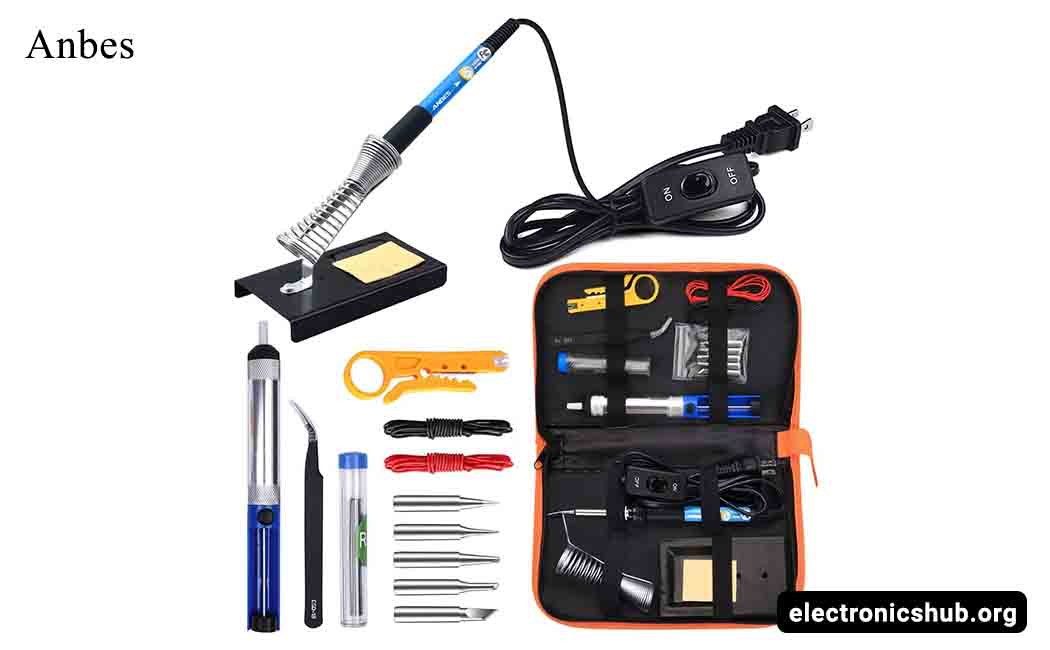
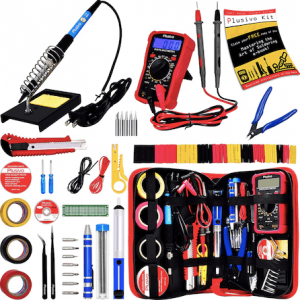
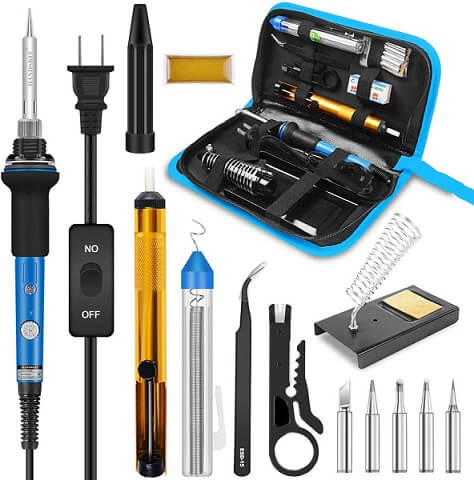
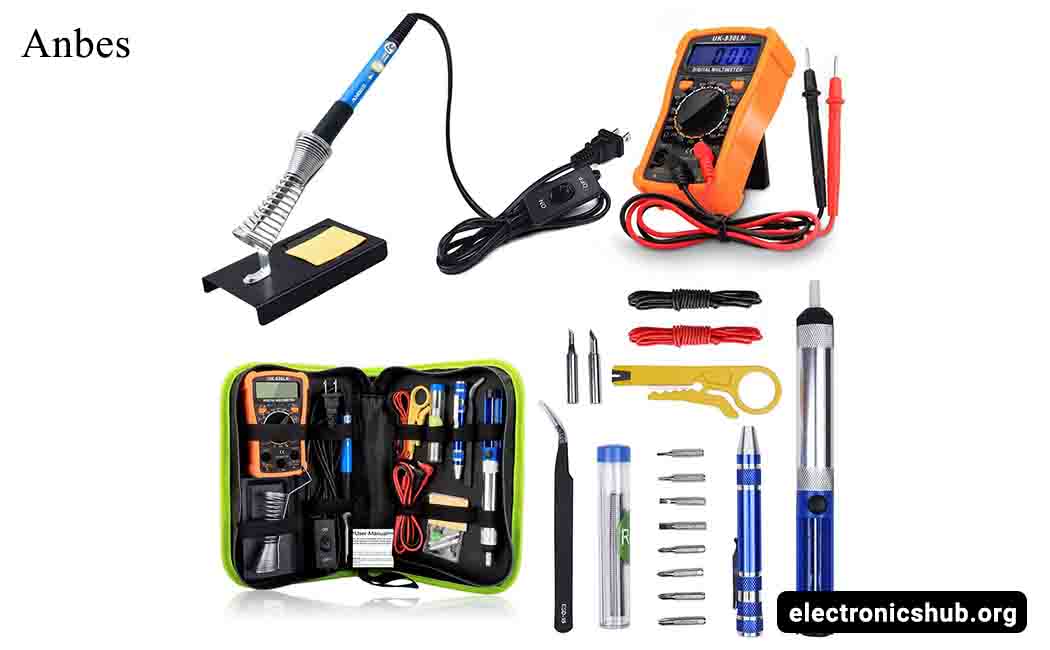
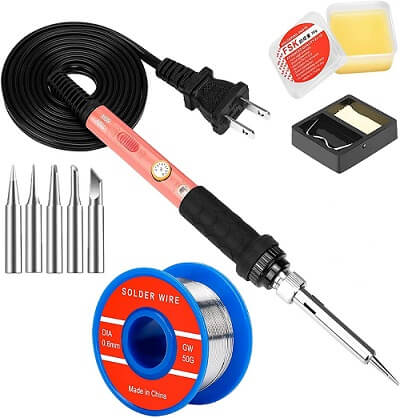
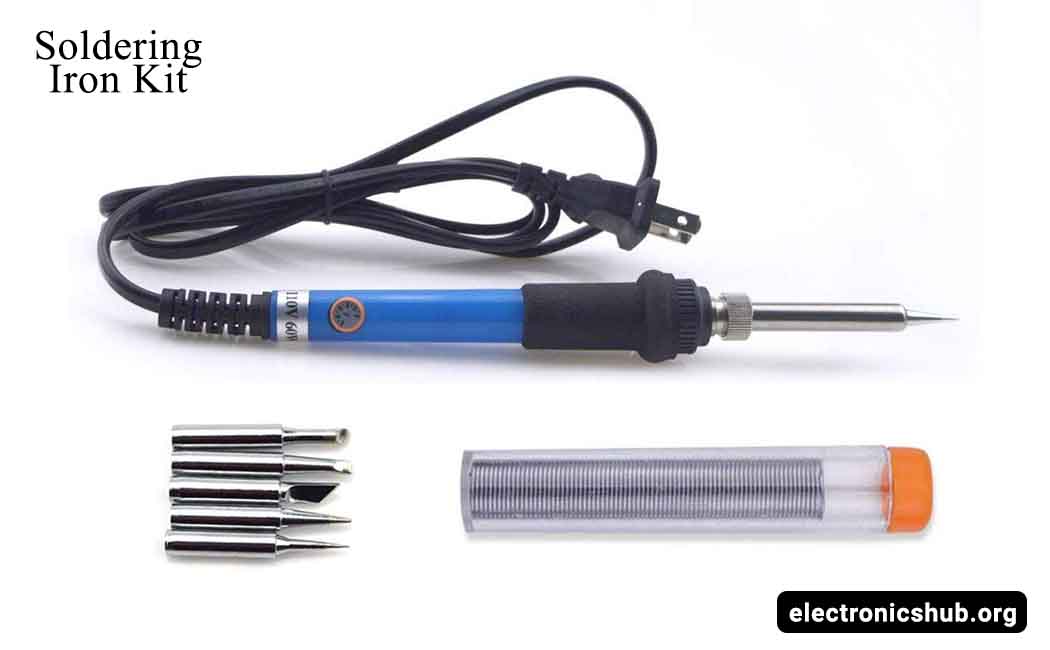
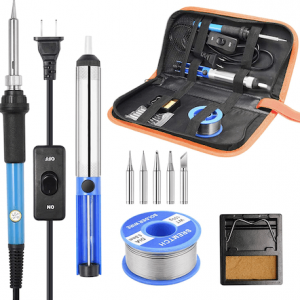
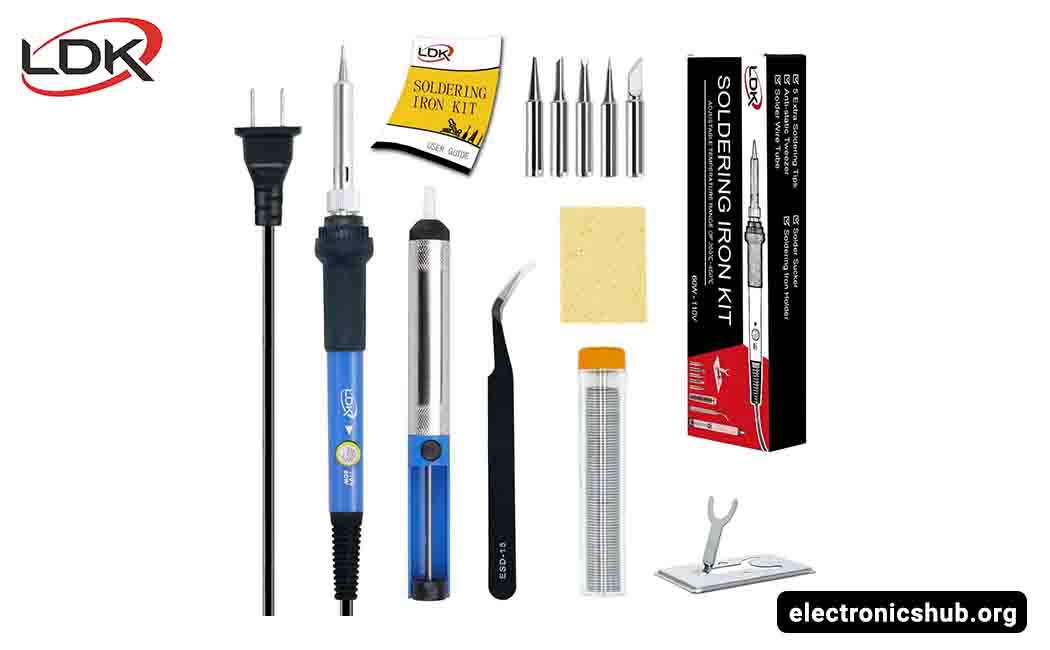
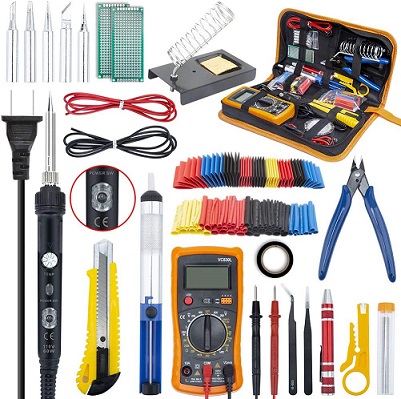
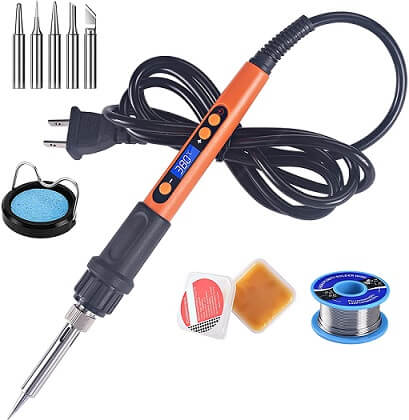


![]()